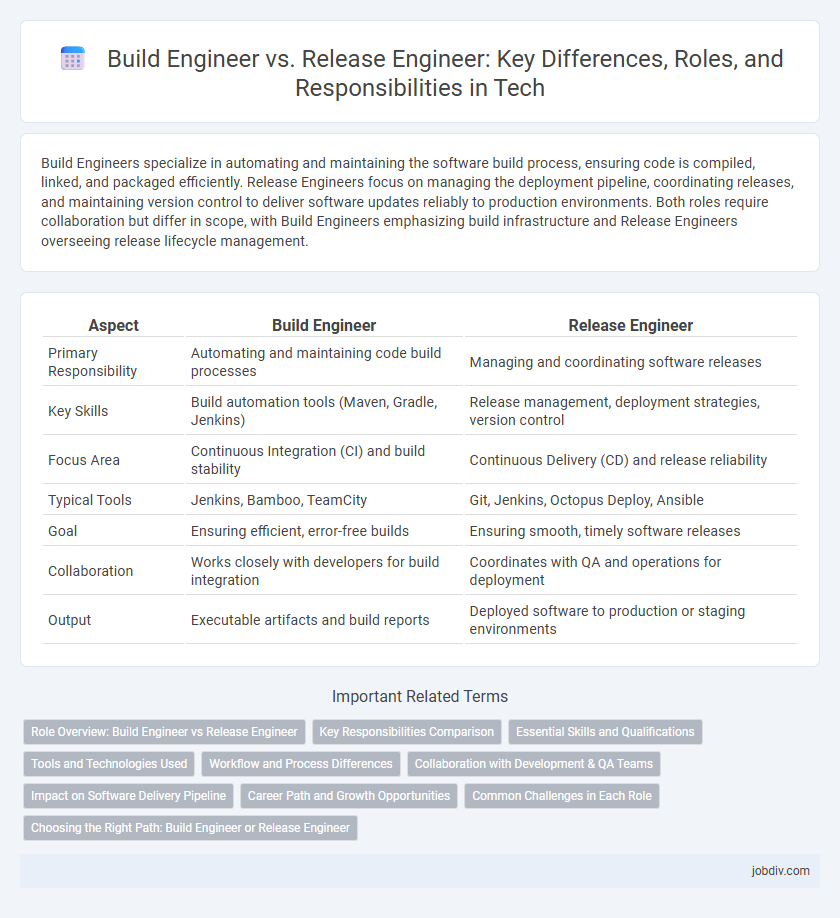Build Engineers specialize in automating and maintaining the software build process, ensuring code is compiled, linked, and packaged efficiently. Release Engineers focus on managing the deployment pipeline, coordinating releases, and maintaining version control to deliver software updates reliably to production environments. Both roles require collaboration but differ in scope, with Build Engineers emphasizing build infrastructure and Release Engineers overseeing release lifecycle management.
Table of Comparison
| Aspect | Build Engineer | Release Engineer |
|---|---|---|
| Primary Responsibility | Automating and maintaining code build processes | Managing and coordinating software releases |
| Key Skills | Build automation tools (Maven, Gradle, Jenkins) | Release management, deployment strategies, version control |
| Focus Area | Continuous Integration (CI) and build stability | Continuous Delivery (CD) and release reliability |
| Typical Tools | Jenkins, Bamboo, TeamCity | Git, Jenkins, Octopus Deploy, Ansible |
| Goal | Ensuring efficient, error-free builds | Ensuring smooth, timely software releases |
| Collaboration | Works closely with developers for build integration | Coordinates with QA and operations for deployment |
| Output | Executable artifacts and build reports | Deployed software to production or staging environments |
Role Overview: Build Engineer vs Release Engineer
Build Engineers specialize in automating and maintaining the software build process, ensuring source code is compiled, integrated, and validated efficiently. Release Engineers manage the packaging, deployment, and distribution of software releases, coordinating version control and environment configurations for production readiness. Both roles require deep expertise in continuous integration and delivery pipelines but focus on distinct stages of the software development lifecycle.
Key Responsibilities Comparison
Build Engineers focus on automating the compilation, integration, and testing of software to ensure consistent and reliable builds across development environments. Release Engineers manage the deployment process, coordinating version control, packaging, and distribution of software releases to production or client systems. Both roles require expertise in continuous integration/continuous delivery (CI/CD) pipelines, but Build Engineers emphasize build automation while Release Engineers prioritize release management and deployment strategies.
Essential Skills and Qualifications
Build Engineers require strong expertise in continuous integration tools, scripting languages such as Python or Bash, and deep knowledge of version control systems like Git. Release Engineers must possess proficiency in release management processes, automation frameworks such as Jenkins or Bamboo, and excellent understanding of deployment strategies across various environments. Both roles benefit from strong problem-solving abilities, collaboration skills, and familiarity with software development lifecycle methodologies.
Tools and Technologies Used
Build Engineers primarily utilize tools such as Jenkins, Maven, Gradle, and Bazel to automate software compilation and integration processes. Release Engineers focus on version control systems like Git, artifact repositories including Nexus or Artifactory, and deployment automation tools such as Ansible, Puppet, or Kubernetes. Both roles require expertise in continuous integration/continuous deployment (CI/CD) pipelines, containerization technologies like Docker, and scripting languages such as Python or Bash to streamline software delivery.
Workflow and Process Differences
Build engineers specialize in automating the compilation and assembly of source code into executable software, managing dependencies, and ensuring build consistency across environments. Release engineers focus on the deployment pipeline, coordinating version packaging, release scheduling, and distribution to production or staging environments with integration of continuous delivery tools. Workflow differences center on build engineers optimizing compilation processes and troubleshooting build failures, while release engineers emphasize orchestrating deployment workflows, rollback plans, and release documentation.
Collaboration with Development & QA Teams
Build Engineers streamline the integration of code by managing automated build systems that continuously compile and validate software, ensuring immediate feedback for developers. Release Engineers coordinate deployment pipelines and version control strategies, facilitating smooth handoffs between development, QA teams, and production environments for reliable software delivery. Both roles require close collaboration with development and QA to detect issues early and maintain high-quality, consistent releases.
Impact on Software Delivery Pipeline
Build Engineers streamline the compilation and integration of source code, directly enhancing the efficiency of the continuous integration process by minimizing build times and errors. Release Engineers manage deployment workflows and version control, ensuring consistent and reliable software delivery across multiple environments. Together, their collaboration optimizes the software delivery pipeline by reducing bottlenecks and accelerating time-to-market for high-quality releases.
Career Path and Growth Opportunities
Build Engineers specialize in automating and optimizing software build processes, gaining expertise in continuous integration tools and scripting, which paves the way to roles like Automation Architect or DevOps Engineer. Release Engineers focus on managing software release cycles, coordinating deployments, and ensuring quality assurance, often progressing toward Release Manager or Configuration Manager positions. Both paths offer growth into senior technical leadership roles, but Build Engineers tend to move deeper into toolchain development, while Release Engineers often advance into strategic release planning and project management domains.
Common Challenges in Each Role
Build engineers often face challenges related to automating complex build processes, managing dependencies, and ensuring consistent build environments across multiple platforms. Release engineers encounter difficulties in coordinating deployment schedules, ensuring version control accuracy, and managing rollback procedures during release failures. Both roles must address integration issues between build and release tools while maintaining high reliability and minimizing downtime in continuous delivery pipelines.
Choosing the Right Path: Build Engineer or Release Engineer
Choosing between a Build Engineer and a Release Engineer depends on your focus within the software development lifecycle; Build Engineers specialize in automating and maintaining build processes, ensuring code compiles correctly and efficiently across environments. Release Engineers manage deployment pipelines, coordinating software releases, version control, and integration with continuous delivery systems. Prioritizing skill sets like scripting and version control for Build Engineers versus deployment automation and environment orchestration for Release Engineers enables targeted career growth.
Build Engineer vs Release Engineer Infographic

 jobdiv.com
jobdiv.com